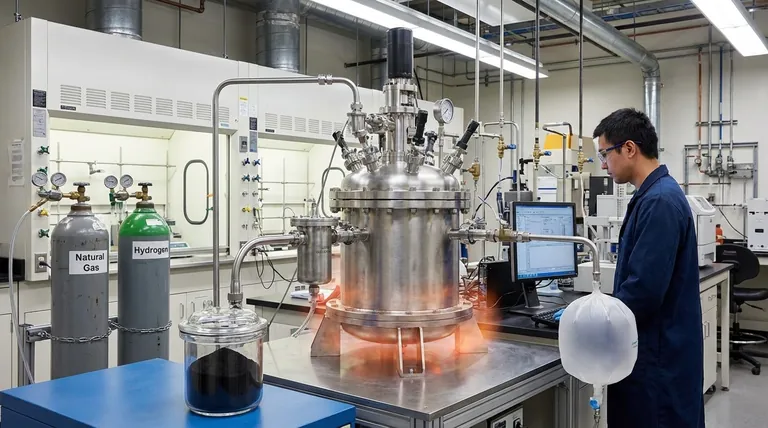Yes, methane pyrolysis is a scientifically proven process that successfully splits methane (CH4) into valuable hydrogen gas and solid carbon, fundamentally avoiding the direct creation of carbon dioxide (CO2). However, its practical viability at an industrial scale is a more complex issue. The core challenge lies in bridging the gap between controlled laboratory experiments and the harsh realities of industrial feedstocks.
While the fundamental chemistry of methane pyrolysis is sound, its real-world success is not guaranteed. The technology's readiness depends entirely on solving the engineering and economic challenges that arise when moving from pure methane to impure, industrial-grade natural gas.

What "Working" Really Means
Methane pyrolysis is often championed as a source of "turquoise" hydrogen—a method that combines the use of natural gas (like grey hydrogen) with zero direct emissions (like green hydrogen).
The Fundamental Reaction
The process uses high temperatures to break methane molecules apart. In its ideal form, the chemical reaction is clean and simple: CH4 (methane) → C (solid carbon) + 2H2 (hydrogen gas). This process is attractive because its only outputs are a valuable gas and a manageable solid, with no CO2 produced in the core reaction.
The Ideal Scenario: Pure Methane
In a laboratory, using pure methane as the feedstock allows for predictable results. Scientists can optimize temperature, pressure, and catalysts to achieve high conversion rates and produce high-purity hydrogen and carbon. This is where most research is focused and where the process "works" most effectively.
The Critical Challenge: Pure Methane vs. Natural Gas
The transition from a lab to an industrial plant introduces a critical complication: the feedstock is no longer pure methane. Industrial operations must use natural gas, which is a mixture of compounds.
The Industrial Reality: Impure Natural Gas
Natural gas contains methane but also includes other components like carbon dioxide (CO2), water (H2O), sulfur compounds, and higher hydrocarbons (ethane, propane). These are not inert bystanders in the pyrolysis reaction; they actively participate and create problems.
How Impurities Disrupt the Process
The additional compounds found in natural gas significantly complicate the pyrolysis process. They can lead to lower conversion rates, reduce the purity of the final hydrogen product, poison the catalysts used to facilitate the reaction, and create unwanted solid deposits that can damage the reactor.
Understanding the Practical Trade-offs
Beyond the feedstock issue, several other factors determine if methane pyrolysis "works" in a practical, economic sense. These are often overlooked in simple assessments.
Energy Efficiency and Heat Loss
The process requires a significant amount of energy to reach the high temperatures needed for pyrolysis. In any real-world facility, process-specific heat loss is a major factor that reduces overall energy efficiency, increasing operational costs.
The Hidden Cost of Hydrogen Compression
The hydrogen produced is a low-density gas. For it to be stored or transported, it must be highly compressed, a process that requires a substantial amount of energy. This energy cost must be factored into the overall efficiency calculation.
Unwanted Side Reactions and Product Purity
The presence of impurities in natural gas can trigger side reactions. These reactions can produce unwanted byproducts like other hydrocarbons and aromatic compounds, contaminating both the hydrogen gas and the solid carbon, potentially requiring costly downstream purification steps.
Making the Right Choice for Your Goal
Evaluating whether methane pyrolysis "works" depends entirely on your objective. The answer is different for a research chemist than it is for a plant operator.
- If your primary focus is foundational research: Methane pyrolysis offers a well-defined and proven process for studying catalyst development and reaction kinetics in a controlled environment.
- If your primary focus is industrial hydrogen production: You must critically assess any proposed solution for its ability to handle impure natural gas feedstock efficiently and economically over a long service life.
Ultimately, the journey of methane pyrolysis from a working chemical principle to a widespread industrial reality depends on solving the complex engineering challenges posed by real-world feedstocks.
Summary Table:
| Aspect | Lab-Scale (Pure Methane) | Industrial-Scale (Natural Gas) |
|---|---|---|
| Feedstock | Pure CH₄ | Impure mix (CH₄, CO₂, H₂O, sulfur) |
| Process | Predictable, high conversion | Complex, prone to side reactions |
| Hydrogen Purity | High | Requires costly purification |
| Carbon Byproduct | Clean, manageable solid | Potentially contaminated |
| Economic Viability | Proven in research | Challenged by energy costs & engineering |
Ready to Scale Your Hydrogen Production with Reliable Lab Solutions?
Navigating the transition from lab research to industrial application requires robust and precise equipment. At KINTEK, we specialize in providing high-quality lab reactors, furnaces, and analytical tools that help you optimize processes like methane pyrolysis under controlled conditions. Whether you're developing catalysts or testing feedstock purity, our equipment delivers the accuracy and durability needed for critical R&D.
Contact us today to discuss how our solutions can support your journey toward efficient, scalable hydrogen production.
Get in Touch
Visual Guide

Related Products
- Customizable High Pressure Reactors for Advanced Scientific and Industrial Applications
- Laboratory Muffle Oven Furnace Bottom Lifting Muffle Furnace
- High Pressure Laboratory Autoclave Reactor for Hydrothermal Synthesis
- High Pressure Laboratory Vacuum Tube Furnace Quartz Tubular Furnace
- Electric Rotary Kiln Small Rotary Furnace Biomass Pyrolysis Plant
People Also Ask
- What are the advantages of a chemical reactor? Unlock Precision, Efficiency, and Safety in Your Process
- How is high pressure generated in an autoclave? Unlock the Science of Sterilization & Synthesis
- How high pressure is created in a lab? Master Safe and Precise Pressure Generation
- What are autoclaves used in the chemical industry? High-Pressure Reactors for Synthesis & Curing
- Does pressure affect melting and boiling? Master Phase Changes with Pressure Control



















